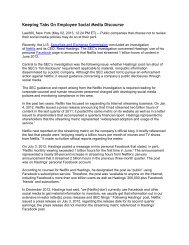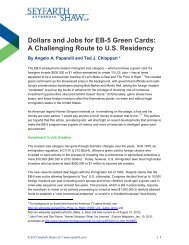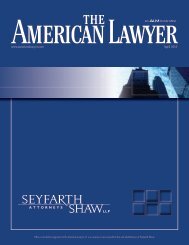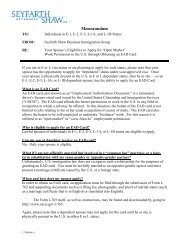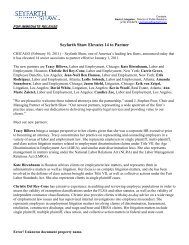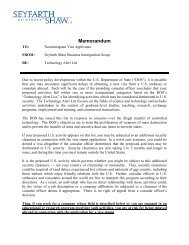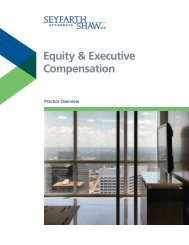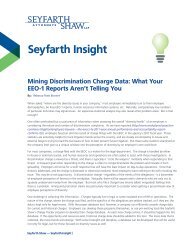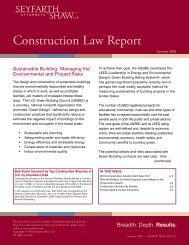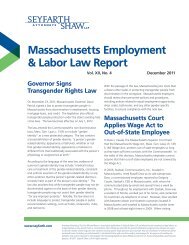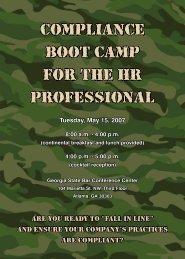Litigating California Wage & Hour and Labor Code Class Actions
Litigating California Wage & Hour and Labor Code Class Actions
Litigating California Wage & Hour and Labor Code Class Actions
Create successful ePaper yourself
Turn your PDF publications into a flip-book with our unique Google optimized e-Paper software.
Similarly, employers may argue that the “commonality” element is missing, thereby<br />
potentially avoiding the creation of a sub-class. Seyfarth Shaw successfully defeated class<br />
certification in Hughes v. WinCo Foods by advancing such an argument. 373 In WinCo,<br />
plaintiff brought a class action alleging that defendant failed to comply with <strong>California</strong> law<br />
with respect to providing meal <strong>and</strong> rest breaks. Plaintiff asserted that the commonality<br />
requirement was satisfied due to the store-wide policy of requiring employees to obtain<br />
management approval before going on a meal break. The court rejected that argument,<br />
explaining that the decision-making as to when employees took breaks varied from store to<br />
store <strong>and</strong> department to department. The court also concluded that the wide variation<br />
among employees even within each department would require “hundreds or thous<strong>and</strong>s of<br />
‘mini trials.’” 374<br />
D. Opt-In <strong>Class</strong>es<br />
Because of the broad language in Sav-On suggesting that trial courts should be innovative<br />
in fashioning class action procedures, 375 some commentators opined that Sav-On was<br />
approving the trial court’s ability to certify an “opt-in” class action, modeled after the<br />
procedure employed in FLSA <strong>and</strong> Age Discrimination in Employment Act (“ADEA”)<br />
collective actions. In 2005, however, the First District <strong>California</strong> Court of Appeal in<br />
Hypertouch, Inc. v. Superior Court 376 barred trial courts from certifying opt-in classes.<br />
In an “opt-in” class action, employees participate in the action only if they “opt in” by signing<br />
a form. Any judgment obtained in the decision binds only those individuals who opted in.<br />
Although this procedure limits the number of class members bound by a decision,<br />
employers generally like it because it reduces the number of employees offered a recovery,<br />
<strong>and</strong> because those employees who elect not to opt in usually lack interest in the litigation<br />
<strong>and</strong> are unlikely to sue later.<br />
Although opt-in classes were rare in <strong>California</strong>, nothing before Sav-On expressly forbade<br />
them (in contrast to Federal Rule of Civil Procedure 23, which forbids opt-in classes except<br />
where, as in the FLSA <strong>and</strong> ADEA, Congress provides that an opt-in class is the only kind<br />
permitted). 377 In barring opt-in classes under state law, the Hypertouch court reasoned that<br />
<strong>Code</strong> of Civil Procedure Section 382 should be interpreted as parallel to Rule 23, which<br />
373<br />
374<br />
375<br />
376<br />
377<br />
2012 WL 34483 (C.D. Cal., January 4, 2012)<br />
See also Hadjavi v. CVS Pharmacy, Inc., 2011 WL 3240763 (C.D. Cal. Jul 25, 2011) (denying class certification of<br />
overtime, meal <strong>and</strong> rest period claims of nonexempt pharmacy employees <strong>and</strong> holding that the allegation that workload<br />
prohibited breaks was not enough to justify certification).<br />
Sav-On, 34 Cal. 4th at 339.<br />
128 Cal. App. 4th 1527 (2005) (modified without change in judgment, 129 Cal. App. 4th 1348 (2005)).<br />
Id. at 1547-48.<br />
Seyfarth Shaw LLP | www.seyfarth.com <strong>Litigating</strong> <strong>California</strong> <strong>Wage</strong> & <strong>Hour</strong> <strong>Class</strong> <strong>Actions</strong> (12th Edition) 81



